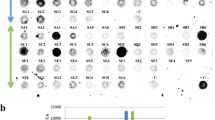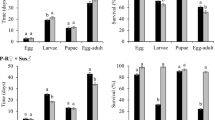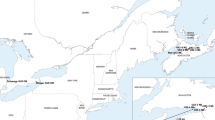Abstract
We introduced a synthetic gene encoding a truncated version of the CryIA(b) protein derived from Bacillus thuringiensis into immature embryos of an elite line of maize using microprojectile bombardment. This gene was expressed using either the CaMV 35S promoter or a combination of two tissue specific promoters derived from maize. High levels of CryIA(b) protein were obtained using both promoter configurations. Hybrid maize plants resulting from crosses of transgenic elite inbred plants with commercial inbred lines were evaluated for resistance to European corn borer under field conditions. Plants expressing high levels of the insecticidal protein exhibited excellent resistance to repeated heavy infestations of this pest.
This is a preview of subscription content, access via your institution
Access options
Subscribe to this journal
Receive 12 print issues and online access
$209.00 per year
only $17.42 per issue
Buy this article
- Purchase on Springer Link
- Instant access to full article PDF
Prices may be subject to local taxes which are calculated during checkout
Similar content being viewed by others
References
Lynch, R.E. 1980. European corn borer: Yield losses in relation to hybrid and stage of corn development. J. Econ. Entomol. 73: 159–164.
Briggs, S.P. and Guse, C.A. 1986. Forty years of European corn borer data: What have we learned? 38th Illinois Custom Spray Operators Training Manual. Coop Ext. Service, University of Illinois, Urbana-Champaign: 169–173.
Showers, W.B., Witkowski, J.F., Mason, C.E., Calvin, D.D., Higgins, R.A. and Dively, G.P. 1989. European corn borer: Development and management, North Central Region Ext. Pub. No. 327. Published by Iowa State University, Ames, Iowa.
Hofte, H. and Whiteley, H.R. 1989. Insecticidal crystal proteins of Bacillus thuringiensis. Microbiol. Rev. 53: 242–255.
Gill, S.S., Cowles, E.A. and Pietrantonio, P.V. 1992. The mode of action of Bacillus thuringiensis endotoxins. Ann. Rev. Entomol. 37: 615–636.
English, L. and Slatin, S.L. 1992. Mode of action of delta-endotoxins from Bacillus thuringiensis: a comparison with other bacterial toxins. Insect Biochem. Molec. Biol. 22: 1–7.
Vaeck, M., Reynaerts, A., Hofte, H., Jansens, S., De Beukeleer, M., Dean, C., Zabeau, M., Van Montagu, M. and Leemans, J. 1987. Transgenic plants protected from insect attack. Nature 328: 33–37.
Barton, K.A., Whiteley, H.R. and Yang, N.-S. 1987. Bacillus thuringiensis δ-endotoxin expressed in transgenic Nicobana tabacum provides resistance to lepidopteran insects. Plant Physiol. 85: 1103–1109.
Fischoff, D.A., Bowdish, K.S., Perlak, F.J., Marrone, P.G., McCormick, S.M., Niedermeyer, J.G., Dean, D.A., Kusano-Kretzmer, K., Mayer, E.J., Rochester, D.E., Rogers, S.G. and Fraley, R.T. 1987. Insect tolerant transgenic tomato plants. Bio/Technology 5: 807–813.
Perlak, F.J., Deaton, R.W., Armstrong, T.A., Fuchs, R.L., Sims, S.R., Greenplate, J.T. and Fischoff, D.A. 1990. Insect resistant cotton plants. Bio/Technology 8: 939–943.
Carozzi, N.B., Warren, G.W.N., Desai, N., Jayne, S.M., Lotstein, R.D.A., Evola, S. and Koziel, M.G. 1992. Expression of a chimeric CaMV 35S Bacillus thuringiensis insecticidal protein gene in transgenic tobacco. Plant Molec. Biol. 20: 539–548.
Murray, E.E., Lotzer, J. and Eberle, M. 1989. Codon usage in plants. Nucl. Acids Res. 17: 477–498.
Perlak, F.J., Fuchs, R.L., Dean, D.A., McPherson, S.L. and Fischoff, D.A. 1991. Modification of the coding sequence enhances plant expression of insect control protein genes. Proc. Natl. Acad. Sci. USA 88: 3324–3328.
Delannay, X., LaVallee, B.J., Proksch, R.K., Fuchs, R.L., Sims, S.R., Greenplate, J.T., Marrone, P.G., Dodson, R.B., Augustine, J.J., Layton, J.G. and Fischoff, D.A. 1989. Field performance of transgenic tomato plants expressing the Bacillus thuringiensis var. kurstaki insect control protein. Bio/Technology 7: 1265–1269.
Warren, G.W., Carozzi, N.B., Desai, N. and Koziel, M.G. 1992. Field evaluation of transgenic tobacco containing a Bacillus thuringiensis insecticidal protein gene. J. Econ. Entomol. 85: 1651–1659.
Geiser, M., Schweitzer, S. and Grimm, C. 1986. The hypervariable region in the genes coding for entomopathogenic crystal proteins of Bacillus thuringiensis: Nucleotide sequence of the kurhdl gene of subsp. kurstaki HD1 Gene 48: 109–118.
Hudspeth, R.L. and Grula, J.W. 1989. Structure and expression of the maize gene encoding the phosphoenolpyruvate carboxylase isozyme involved in C4 photosynthesis. Plant Molec. Biol. 12: 579–589.
Thompson, C.J., Movva, N.R., Tizard, R., Crameri, R., Davies, J.E., Lauwereys, M. and Botterman, J. 1987. Characterization of the herbicide-resistance gene bar from Streptomyces hygroscopicus. The EMBO J. 6: 2519–2523.
Fromm, M.E., Morrish, F., Armstrong, C., Williams, R., Thomas, J. and Klein, T.M. 1990. Inheritance and expression of chimeric genes in the progeny of transgenic maize plants. Bio/Technology 8: 833–839.
Gordon-Kamm, W.J., Spencer, T.M., Mangano, M.L., Adams, T.R., Daines, R.J., Start, W.G., O'Brien, J.V., Chambers, S.A., Adams, W.R., Willetts, N.G., Rice, T.B., Mackey, C.J., Krueger, R.W., Kausch, A.P. and Lemaux, P.G. 1990. Transformation of maize cells and regeneration of fertile transgenic plants. The Plant Cell 2: 603–618.
Genovesi, D., Willetts, N., Zachwieja, S., Mann, M., Spencer, T., Flick, C. and Gordon-Kamm, W. 1992. Transformation of an elite maize inbred through microprojectile bombardment of regenerable embryogenic callus. In Vitro Cell. Dev. Biol. 28: 124A.
Walters, D.A., Vetsch, C.S., Potts, D.E. and Lundquist, R.C. 1992. Transformation and inheritance of a hygromycin phosphotransferase gene in maize plants. Plant Molec. Biol. 18: 189–200.
Yanisch-Perron, C., Vieira, J. and Messing, J. 1985. Improved M13 phage cloning vectors and host strains: nucleotide sequences of the M13mpl8 and pUC19 vectors. Gene 33: 103–119.
Rothstein, S.J., Lahners, K.N., Lotstein, R.J., Carozzi, N.B., Jayne, S.M. and Rice, D.A. 1987. Promoter cassettes, antibiotic-resistance genes, and vectors for plant transformation. Gene 53: 153–161.
Duncan, D.R., Williams, M.E., Zehr, B.E. and Widholm, J.M. 1985. The production of callus capable of plant regeneration from immature embryos of numerous Zea mays genotypes. Planta 165: 322–332.
Murashige, T. and Skoog, F. 1962. A revised medium for rapid growth and bioassays with tobacco tissue cultures. Physiol. Plant. 15: 473–497.
Kramer, C., Shillito, R.D. and DiMaio, J.J. 1992. The chlorophenol red assay— a pH indicator test to identify maize transformants containing the BAR gene. Proceedings of the 1992 Miami Bio/Technology Winter Symposium 1: 38.
Jefferson, R.A. 1987. Assaying chimeric genes in plants: The GUS gene fusion system. Plant Molec. Biol. Rep. 5: 387–405.
Gamborg, O.L., Miller, R.A. and Ojima, K. 1968. Nutrient requirements of suspension cultures of soybean root cells. Exp. Cell Res. 50: 151–158.
Weymann, K., Urban, K., Ellis, D., Novitzky, R., Dunder, E., Jayne, S., Murray, D., Jen, G. and Pace, G. 1993. Isolation of transgenic progeny of maize by embryo rescue under selective conditions. In Vitro Cell. Dev. Biol. In press.
Davis, F.M., Williams, W.P. and Wiseman, B.R. 1989. Methods used to screen maize for resistance to the southwestern corn borer and fall armyworm and to determine mechanisms of resistance. p. 101–108. In: Toward insect resistant maize for the third world: Proceedings of the International Symposium on Methodologies for Developing Host Plant Resistance to Maize Insects. CIMMYT.
Guthrie, W.D., Dicke, F.F. and Neiswander, C.R. 1960. Leaf and sheath feeding resistance to the European corn borer in eight inbred lines of dent corn. Ohio Agric. Exp. Stn. Res. Bull. 860: 38pp.
Clark, M.F., Lister, R.M. and Bar-Joseph, M. ELISA Techniques. Methods in Enzymol. 118: 742–766.
SAS Institute. 1991. SAS/STAT User's Guide, release 6.03. SAS Institute, Cary, NC.
Sambrook, J., Fritsch, E.F. and Maniatis, T. 1989. Molecular Cloning: A Laboratory Manual, second edition. Cold Spring Harbor Laboratory Press.
Author information
Authors and Affiliations
Rights and permissions
About this article
Cite this article
Koziel, M., Beland, G., Bowman, C. et al. Field Performance of Elite Transgenic Maize Plants Expressing an Insecticidal Protein Derived from Bacillus thuringiensis. Nat Biotechnol 11, 194–200 (1993). https://doi.org/10.1038/nbt0293-194
Received:
Accepted:
Issue Date:
DOI: https://doi.org/10.1038/nbt0293-194
This article is cited by
-
A novel, simple, and stable mesoporous silica nanoparticle-based gene transformation approach in Solanum lycopersicum
3 Biotech (2020)
-
Particle bombardment technology and its applications in plants
Molecular Biology Reports (2020)
-
Co-culturing on dry filter paper significantly increased the efficiency of Agrobacterium-mediated transformations of maize immature embryos
Physiology and Molecular Biology of Plants (2019)
-
Expression of cry genes in Bacillus thuringiensis biotechnology
Applied Microbiology and Biotechnology (2019)
-
Pool deconvolution approach for high-throughput gene mining from Bacillus thuringiensis
Applied Microbiology and Biotechnology (2018)



